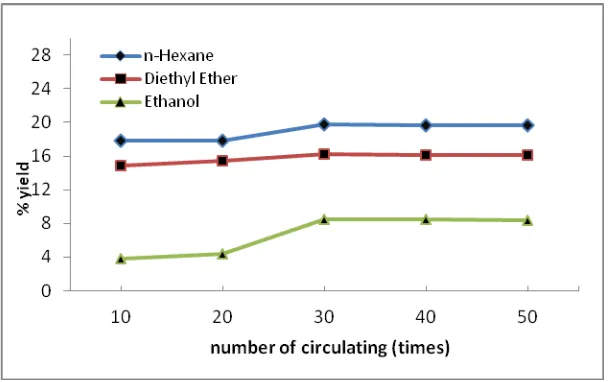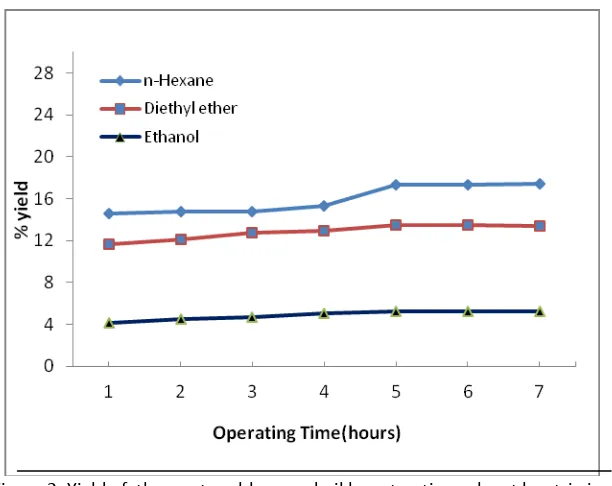International Conference on
Chemical and Material Engineering 2012 ISBN : 978-602-097-281-7
SPE.10 - 1
Department of Chemical Engineering Diponegoro University September 12 – 13, 2012, Semarang Indonesia
Oil Extraction Process from Solid Waste Rubber Seed by
Soxhletation and Extraction Solvent by Stirring Methods
Achmad Wildana, Devina Ingrid Ab, Indah Hartatic
a,b “ekolah Ti ggi Il u Far asi Yayasa Phar asi “e ara g
Jl. Sarwo Edhie Wibowo Km. 1 Plamongansari, Pucanggading Semarang
c
Wahid Hasyim University
Jl. Menoreh Tengah X/22 Semarang
Abstract
Indonesia is a country rich with the natural resources. One of them is rubber plant. Beside latex as its main product, rubber tree also produces rubber seed. Rubber seed contains rubber seed oil. In the oil extraction process using mechanical methods, around 30% rendemen is obtain, while the oil content in the rubber seed is around 50 – 60%. Thus, the oil content remained in the waste rubber seed is still plentiful. The oil taking process from the waste rubber seed is done by soxhletation and extraction using strirring. The purpose of this research is to compare the extraction methods of waste rubber seed oil with solvent by soxhletation and extraction solvent by stirring with several solvents to get the most rubber seed waste oil, as well as to analyze the chemical physical properties of waste rubber seed oil. In this research, the yield of the soxhletation result with the same solvent was obtained more than the one with exctration by stirring. The most yield is obtained from the extraction by soxhletation with n-hexane with 30 times of total circulation with the result 19.80 % and the oil chemical physical properties among others viscosity 59.4358 cp, Spesific gravity 0.9324, refractive index 1.583, iodine numbers 179.1730 mg/g, saponification number 172.1848 mgKOH/g, acid number 37.8267 mg/g
Keywords: Extraction, Rubber, Soxhletation, Waste Rubber Seed Oil, Yiled,
1. Introduction
Indonesia is a country rich with natural resources which can be used in various aspects of life. Some of them are used as food resources and the potential energy resources. One of the excessive vegetation resources is rubber plant. Indonesia is the one biggest rubber producers in the world. The main product of rubber plantation is latex. But, apart of it, rubber tree also produces rubber seed in a large amount. With the progress of the need for the oil resource, the use of rubber seed oil has been intensely researched. The composition of rubber seed oil contains fatty acids which have the benefit and high economic values such as palmitic acid, stearic, oleic, linoleic,
and linolenic [2]. Rubber seed oil was taken by pressing method using hydraulic press. Withdrawal of rubber seed
oil from the seeds using a rubber pressing process will generate waste in the form of rubber seed which use has not been developed yet.
Waste rubber seed yield pulp presses rubber seeds still contain a composition of rubber seed oil can still be taken to be used as rubber seed oil pressing results. Extraction of rubber seed waste can quote from rubber seed oil remaining on the less after the pressing process. Extraction will get optimum results when performed with appropriate methods and solvent.
Extraction / separation is described as the process of moving one or more components from one phase to another phase [1]. One technique of exctraction is the solvent extraction. This type of separation process always involves two phases. Ideally, the two phases are not mutually dissolved during the extraction process takes place. Sample can be a gas, a liquid or a solid.
Meanwhile, Vogel (1984) explains that by using the solvent extraction separation process component is based on the nature of the solute distribution in the two solvents are not mutually dissolved. By using the differences in solubility, the desired compound can be selectively separated. This was confirmed by Khopkar (1990) who explains that the selectivity of the solvent in the other solvents of different polarity in dissolving organic compounds would form two separate layers each, where the process is based on the distribution of the sample between the two solvents.
International Conference on
Chemical and Material Engineering 2012 ISBN : 978-602-097-281-7
SPE.10 - 2
Department of Chemical Engineering Diponegoro University September 12 – 13, 2012, Semarang Indonesia
2. Materials and Methods
Materials: Waste Rubber Seed, n-hexane, diethyl ether, ethanol, KOH, methanol, sulfuric acid, phosphoric acid, acetonitrile, HCL, PP indicator, diethyl ether, toluene, isopropanol, acids periodate, sodium thiosulfate, KI, glacial acetic acid , starch indicator, chloroform, potassium bichromate, boron trifluoride, methanol.
Equipment: Soxhlet apparatus, magnetic stirer, glassware, rotary vacuum evaporator, analytical balance, waterbath, burette, Pycnometer, viscosemeter Ostwald, refractometer, glass tools, clamps, stative, separating funnel.
Procedure: For Soxhletation Methods, first weighed 40 gram waste rubber seed, put in a filter paper that had been formed bag, then put into the tube chiffon, added with 400 ml of solvent used. By varying the amount of circulating extraction soxhletation 10,20,30,40,50 circulation. Vegetable oil extraction from rubber seed residues is done by using n-hexane, diethyl ether and ethanol. The third use of solvents is based on differences in polarity of the three types of solvent. For the method of extraction with stirring, first weighed 40 grams of rubber seed pulp, put into a glass beaker, add 400 ml solvent used, stirring by Magnetic stirrer with extraction time variety of 1, 2, 3, 4, 5, 6, and 7 hours. Crude oil results is then purified by phosphoric acid 20% solution as much as 0.2 to 0.3% (v / w) was heated at 70 ° C and stirred for 25 minutes and the mixture was decanted for 15 minutes. Separate oil washing with water temperature of 60-70 °C to reach neutral pH and then centrifuged for 15 minutes. Then chemical physical properties test include acids number, saponification number, density test, viscosity test, iodine number .
3. Results and Discussion
The extraction process was done in two ways, namely by soxhletationi and solvent extraction by stirring. The solvent used in each of extraction methods are n-hexane, diethyl ether and ethanol. The purpose of using the solvents described above was in order to investigated the influence of the polarity of the solvents towards the yield and characteristic of the oil. The processing step are the extraction and degumming process. The extraction process was gave crude oil and the degumming process was intended to separate the oil from the impurities such as gum. The result of the complete process is pure oil of rubber seed. The yield of the oil obtained from soxhletation methods are given on figure 1.
Figure 1. Yield of waste rubber seed oil by soxhletation methods
International Conference on
Chemical and Material Engineering 2012 ISBN : 978-602-097-281-7
SPE.10 - 3
Department of Chemical Engineering Diponegoro University September 12 – 13, 2012, Semarang Indonesia Figure 2. Yield of the waste rubber seed oil by extraction solvent by strirring
As shown on 2 above for optimum operating time for the extraction solvent with stirring was 5 hours because after that there is no increase in levels of greater yield. Of the three solvents, the largest yield obtained from n-hexane solvent is equal to 17.37%.
The yield of oil is one of the parameters used to determine the amount of oil produced in the extraction process. The yield is calculated by comparing the amount of oil produced from each treatment by the number of ingredients (meat beans) were used. The yield obtained in sokhletation method showed higher yields than extraction method by stirring with heating occurs due to damage to the cell wall, so that the cell wall will be easily solved. Thus, the cell wall is easily penetrated by oil or grease that oils will be easy to get out. The Chemical Physical Properties data of the oil were given in table below
Table 1. Chemical Physical Properties Data
No. Chemical Physical Properties Soxhletation Solvent Extraction by
Strirring
1. Viskositas (cp) 59,4358 61,4443
2. Bobot jenis 0,9324 0,9325
3. Indeks bias 1,583 1,479
4. Bilangan iod (mg/g) 179,1730 183,4628
5. Bilangan penyabunan (mg
KOH/g)
172,1848 173,0175
6. Bilangan asam (mg/g) 37,8267 35.7503
The viscosity, specific gravity and refractive index of rubber seed oil residues generated between soxhletation and solvent extraction methods with stirring were similar. It might be due to the similarity of the fatty acid composition of the oil.
International Conference on
Chemical and Material Engineering 2012 ISBN : 978-602-097-281-7
SPE.10 - 4
Department of Chemical Engineering Diponegoro University September 12 – 13, 2012, Semarang Indonesia The decreasing of the unsaturation will impacted on the decreaasing of the iod value. Moreover, the higher the temperature applied, the more the oil that is oxidized. The oxidation process is happen when the oxygen interact with the oil of the seed or oil that has been removed from the seed matrix. Oxidation is the main process that effect the decreasing of an oil unsaturation. This process can be triggered by high temperature, the existence of peroxide, lipoxidase enzyme, metal ion, and Fe-organic catalyst. The heating process applied on the rubber seed has also caused the incresing temperature of the oil component of the seed. The higher the temperature and along with the heating duration, thus the more the heat energy accepted by the seed and the oil component of the seed. It triggered chemical reaction of oil components which has also triggered the chemical degradation of the components. High temperature heating accompanied by the existence of oxygen has also caused the damage of unsaturated fatty acid of the oil. The decreasing of the ion value was the indicator of the oil damage caused by excessive heating.
Saponification number is a measure of the average molecular weight (or chain length) of all the fatty acids
present. As most of the mass of a fat/triester is in the 3 fatty acids, it allows for comparison of the average fatty acid chain length. The long chain fatty acids found in fats have a low saponification value because they have a relatively fewer number of carboxylic functional groups per unit mass of the fat as compared to short chain fatty acids. Moreover, a high saponificatioan value thus the oil is cosntructed by short chain fatty acid. The saponification value of a vegetable oil is between 183–253 mg KOH/g [5].
Numbers acid is one of the parameters that determine the quality of the oil. Measurement of acid value indicates how much of the amount of free fatty acids contained in the oil due to the hydrolysis process. The higher the value of an oil acid number, the higher the level of damage due to the amount of triglyceride molecules any more. Thus, the quality of the oil will be lower.
Formation of free fatty acids in the oil can occur due to processing (preparation of materials). The process of hydrolysis can take place at the time the oil is still in the seed tissue that has been harvested, during processing, and legal ten-storage services. From the data analysis results obtained from the acid number soxhletation method showed a higher rate than than the method of solvent extraction with stirring.
4. Conclusion
The results of this study demonstrate for soxhletation extraction methods produce a greater yield than extraction by stirring at optimum conditions and the analysis of chemical physics at the quality of the oil obtained by stirring extraction method is better than the methods soxhletation.
References
[1] Kellner RJ, Mermet M, Otto M, Valcarcal M, Widmer HM. 2004. Analytical Chemistry: A Modern Approach to Analytical Science, Second Edition, Wiley-VCH, New York.
[2] Ketaren S. 1986. Oils and Fats Food. UI- Press. Jakarta
[3] Khopkar SM. 1990. The Basic Concept of Analytical Chemistry. UI-Press, Jakarta
[4] Vogel AI. 1984. Textbook of Macro and Semimicro Qualitative Inorganic Analysis. Longman Group Limited. London

